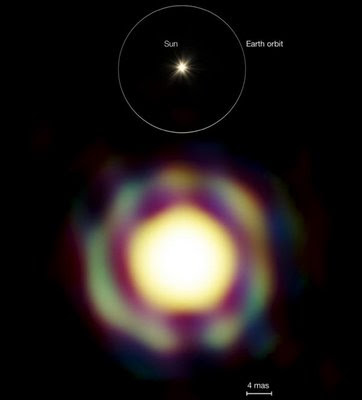The first generation of stars consisted mostly of hydrogen and helium. These stars then seeded the interstellar medium with heavier elements, shedding material via massive winds, planetary nebulae and supernova explosions.
This material then became the building blocks for the next generation of stars and planets. Understanding mass loss is essential for following the evolution of single stars, binaries, star clusters, and galaxies.
However, mass loss is among our weakest areas in understanding fundamental stellar processes. In large part, this is due to lack of detailed, direct observations of stellar photospheres and the mass-loss process. High-resolution optical interferometry with telescope arrays is beginning to provide these data, ushering in a promising a new era in mass-loss studies.
The angular resolution that a telescope can achieve is proportional to its diameter. The larger the telescope, the better its resolution. The purpose of astronomical interferometry is to mix signals from a collection of telescopes to produce images having the same angular resolution as an instrument the size of the entire collection.
Recently, a team of French astronomers captured one of the sharpest color images ever made. The team members are Jean-Baptiste Le Bouquin and Antoine Mérand (ESO), Sylvestre Lacour and Stéphanie Renard (LAOG, CNRS, Grenoble, France), and Eric Thiébaut (AIRI, Observatoire de Lyon, France).
The image was taken over several consecutive nights with ESO's Very Large Telescope Interferometer (VLTI), a virtual telescope about 100 meters across. The result is an amazing image that reveals a spherical molecular shell around an evolved Mira star, T Leporis, 500 light-years away!
 Image showing T Leporis' atmospheric layers and the size of the star relative to the diameter of the Earth's orbit.
Image showing T Leporis' atmospheric layers and the size of the star relative to the diameter of the Earth's orbit.(Credit: ESO)
Miras are giant pulsating variable stars. Evolved stars like this have used up most of their nuclear fuel, causing them to swell up to enormous radii and become unstable. This internal instability causes them to expand and contract more or less regularly. T Lep pulsates with a period of 380 days, and in the process loses the equivalent of the Earth’s mass every year to space. In the end, all that is left is a white dwarf, the ash of the core, surrounded by the gases lost to space from the star’s wind and tenuous grip on its outer layers. We see these stellar remnants as planetary nebula elsewhere in the galaxy. Our Sun will become a Mira in a few billion years, engulfing the inner planets in its final blaze of glory.
Mira stars are among the biggest factories of molecules and dust in the Universe. Since the molecules and dust are formed in the outer layers of a Mira's atmosphere, astronomers would like to be able to see these layers to better understand the processes of mass loss and dust formation. Until now, this has been all but impossible due to the distance to even the nearest stars. The angular size of even giant swollen stars like T Lep were too small to image from Earth.
“T Leporis looks so small from the Earth that only an interferometric facility, such as the VLTI at Paranal, can take an image of it. VLTI can resolve stars 15 times smaller than those resolved by the Hubble Space Telescope,” says Le Bouquin.
“We were able to construct an amazing image, and reveal the onion-like structure of the atmosphere of a giant star at a late stage of its life for the first time,” says team member, Antoine Mérand. “Numerical models and indirect data have allowed us to imagine the appearance of the star before, but it is quite astounding that we can now see it, and in color.
Obtaining images like these was one of the main motivations for building the Very Large Telescope Interferometer. We have now truly entered the era of stellar imaging.”
400 years after Galileo turned his tiny telescope towards the sky, we can now actually see stars atmospheres directly, using some of astronomy's most amazing new tools of discovery.

No comments:
Post a Comment